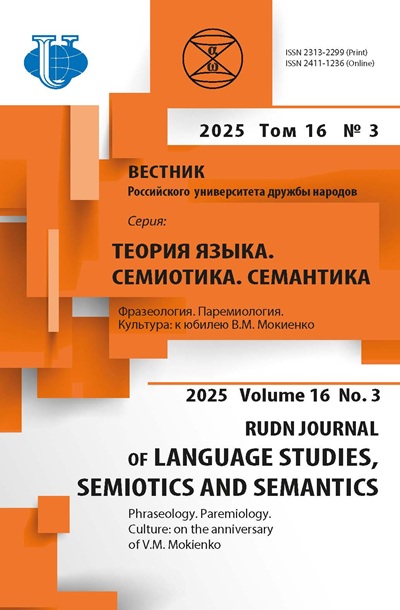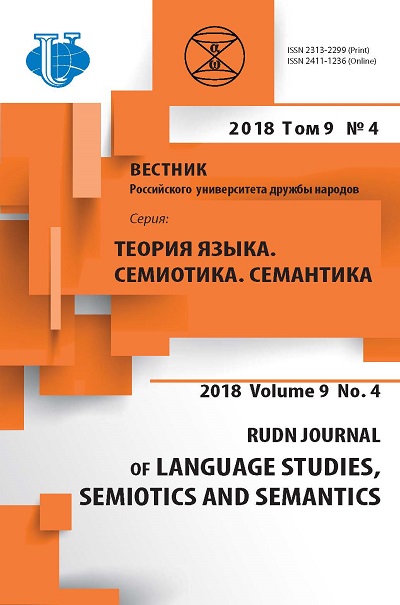СИМУЛЯКР В В СТАТИКЕ И ДИНАМИКЕ ЭКРАННОГО ПРОСТРАНСТВА ТЕКСТА (тематическое исследование поликодовыхмультимодальных текстов Интернета)
- Авторы: Евграфова Ю.А.1, Максименко О.И.1
-
Учреждения:
- Московский государственный областной университет
- Выпуск: Том 9, № 4 (2018)
- Страницы: 831-841
- Раздел: ТЕОРИЯ ЯЗЫКА
- URL: https://journals.rudn.ru/semiotics-semantics/article/view/20141
- DOI: https://doi.org/10.22363/2313-2299-2018-9-4-831-841
- ID: 20141
Цитировать
Полный текст
Аннотация
С наступлением компьютерной, электронной революции, с распространением сети Интернет современная мировая культура имеет в своей основе уже не книжную, а экранную форму существования текста. На смену гомогенному печатному тексту пришли тексты гетерогенные, или аудиовизуальные, к наиболее сложившимся представителям которых можно отнести кино и телевидение, на базе которых сформировались тексты своеобразной структуры, принципиально совмещающей языковые устные и письменные носители смысла с неязыковыми, и которые, превратившись в «цифру», доминируют на сегодняшний день в сети Интернет, от которых зритель ожидает наличия таких стилистических черт, как достоверность и фактологическая точность. Именно данное ожидание активно эксплуатируется авторами подобных видео с целью манипуляции зрителем для создания впечатления, что демонстрируемые объекты и явления имеют денотаты в реальном мире, заставляя реципиента поверить в созданную модель действительности, порождая, таким образом, симулякры. Данная статья посвящена анализу особенностей конструирования симулякров в поликодовыхполимодальных текстах как семиотически осложненных и представляющих собой сложный семиотический комплекс вербальных, иконических и акустических компонентов. Также рассматривается, каким образом создается правдоподобная модель действительности на примере трех поликодовыхполимодальных текстов, описывающих боевые действия в Сирии. Анализ производится в статике и динамике экранного пространства текста: на визуальном (кадры), вербальном и акустическом уровнях. В ходе исследования выделяются лингвосемиотические особенности порождения симулякров в статике экрана, а также перечисляются инструменты, используемые для конструирования симулякров в динамике экрана.
Ключевые слова
Об авторах
Юлия Александровна Евграфова
Московский государственный областной университет
Автор, ответственный за переписку.
Email: 212.155.04@mail.ru
кандидат филологических наук, доцент, доцент кафедры индоевропейских и восточных языков, лингвистический факультет, Институт лингвистики и межкультурной коммуникации, Московский государственный областной университет
ул. Радио, д.10A, Москва, Россия, 105005Ольга Ивановна Максименко
Московский государственный областной университет
Email: maxbel7@yandex.ru
доктор филологических наук, профессор, профессор кафедры теоретической и прикладной лингвистики, лингвистический факультет, Институт лингвистики и межкультурной коммуникации, Московский государственный областной университет
ул. Радио, д.10A, Москва, Россия, 105005Список литературы
- Маклюэн Г.М. Понимание Медиа: Внешние расширения человека / Пер.с англ. В. Николаева; Закл. ст. М. Вавилова. М.; Жуковский: КАНОН-пресс Ц., Кучково поле, 2003.
- Эко У. От Интернета к Гутенбергу: текст и гипертекст: отрывки из публичной лекции Умберто Эко на экономическом факультете МГУ 20 мая 1998 [Электронный ресурс]. Режим доступа: http://vzms.org/umberto.html (Дата обращения: 10.08.2018).
- Сорокин Ю.А., Тарасов Е.Ф. Креолизованные тексты и их коммуникативная функция // Оптимизация речевого воздействия. М.: Наука, 1990. С. 180—186.
- Анисимова Е.Е. Лингвистика текста и межкультурная коммуникация: на материале креолизованных текстов. М.: Academia, 2003.
- Бернацкая А.А. К проблеме «креолизации» текста: история и современное состояние // Речевое общение: Специализированный вестник. Красноярск: Краснояр. гос. ун-т, 2000. Вып. 3 (11).
- Большакова Л.С. О содержании понятия «поликодовый текст» // Вестник Новгородского государственного университета. 2008. № 49. С. 48—51.
- Сонин А.Г. Моделирование механизмов понимания поликодовых текстов: дис.. докт. филол. наук. М., 2006.
- Максименко О.И. Поликодовый vs. креолизованный текст: проблема терминологии // Вестник РУДН. Серия: Теория языка. Семиотика. Семантика. 2012. № 2. С. 93—102.
- Кобзева Е.В. Поликодовый текст как объект филологического анализа // Известия Волгоградского государственного педагогического университета. 2017. № 10 (123). С. 58—62.
- Костомаров В.Г. Экранные тексты и диалог культур // Диалог культур в условиях глобализации: XI Международные Лихачевские научные чтения. Санкт-Петербург, 12— 13 мая 2011 г. СПб.: СПбГУП, 2011. Т. 1. С. 88—92.
- Чернявская В.Е. Лингвистика текста: поликодовость, интертекстуальность, интердискурсивность. М.: ЛИБРОКОМ, 2009.
- Пойманова О.В. Семантическое пространство видеовербального текста: автореф. дис.. канд. филол. наук. М., 1997.
- Батай Ж. Внутренний опыт. СПб.: Аксиома, Мифрил, 1997.
- Делёз Ж. Логика смысла. М. — Екатеринбург, 1998.
- Деррида Ж. Позиции. Киев, 1996.
- Бодрийяр Ж. Симулякры и симуляции. М.: ИД «ПОСТУМ», 2017.
- Клоссовски П. Симулякры Жоржа Батая // Танатография эроса. СПб., 1994. С. 79—91.
- White Helmets Rescue Mission — February 2018, United States Holocaust Memorial Museum, 23.03.2018. Режим доступа: https://www.youtube.com/watch?v=5D2bW9XsdjI (дата обращения: 23.05.2018).
- Syria’s White Helmets: Saving Humanity, 13.12.2016, Режим доступа: https://www.youtube.com/ watch?v=qqXzaYeKaxQ (дата обращения: 23.05.2018).
- Aftermath of suspected chemical attack in rebel-held Douma in Syria, Guardian News, 09.04.2018. Режим доступа: https://www.youtube.com/watch?v=jNIp1lZwJts (дата обращения: 23.05.2018).
Дополнительные файлы












